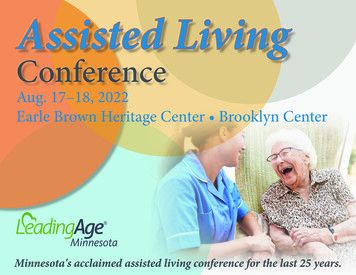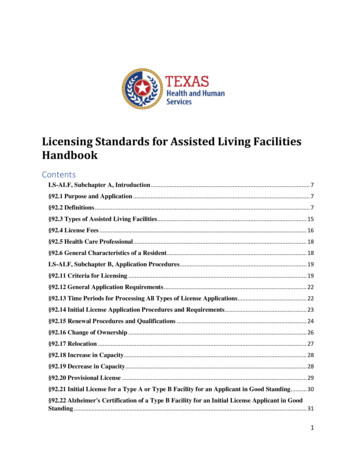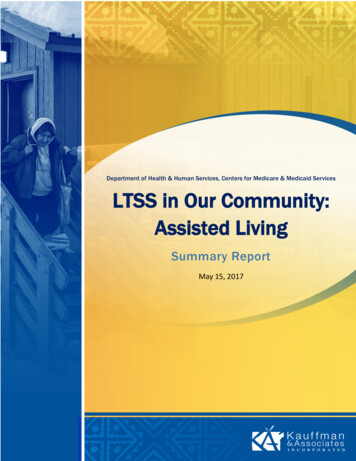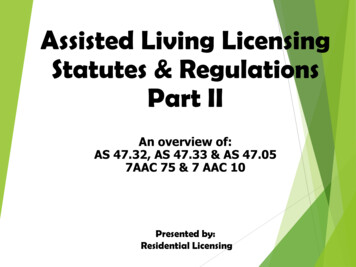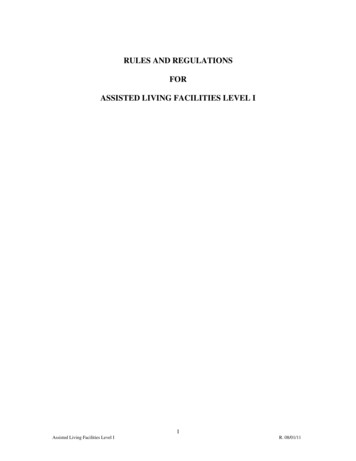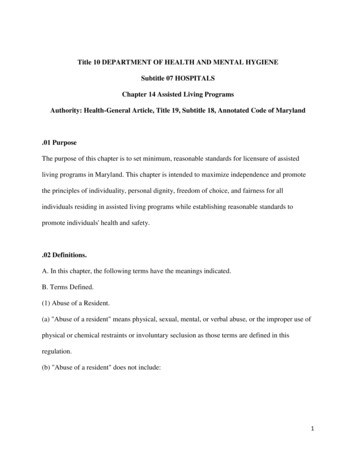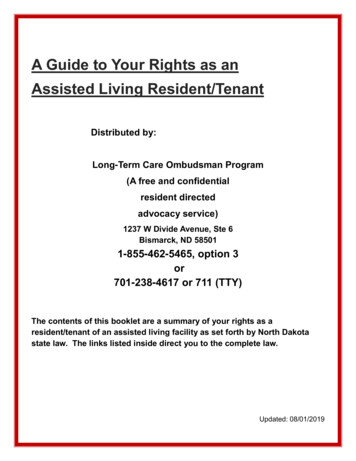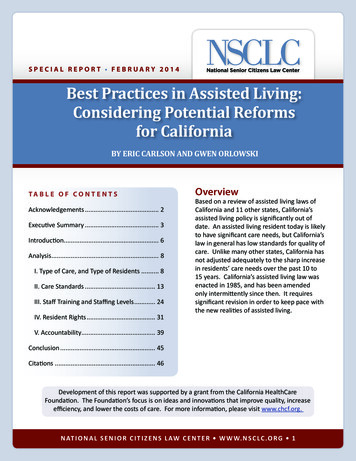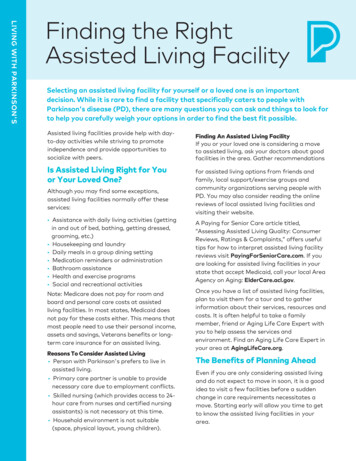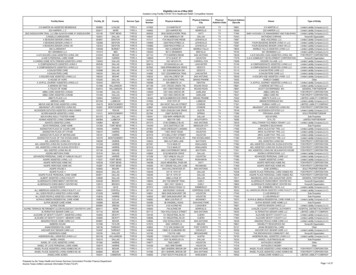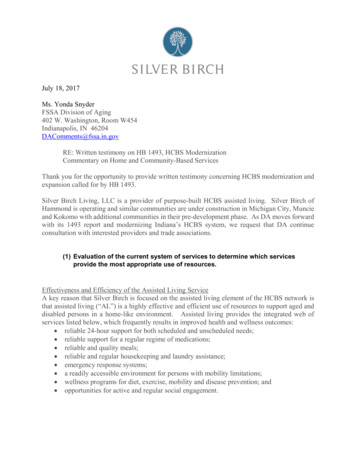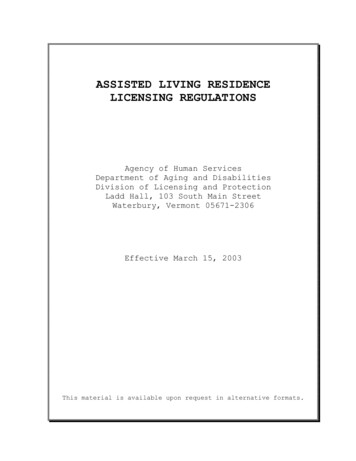
Transcription
ASSISTED LIVING RESIDENCELICENSING REGULATIONSAgency of Human ServicesDepartment of Aging and DisabilitiesDivision of Licensing and ProtectionLadd Hall, 103 South Main StreetWaterbury, Vermont 05671-2306Effective March 15, 2003This material is available upon request in alternative formats.
TABLE OF CONTENTSI.General Provisions. . . . . . . . . . . . . . .1II.Exceptions. . . . . . . . . . . . . . . . . .2III.Definitions. . . . . . . . . . . . . . . . . .2VI.Variances. . . . . . . . . . . . . . . . . .3V.Licenses. . . . . . . . . . . . . . . . . .3VI.Resident Care and ServicesVII.Policies and ProceduresVIII.Agreements and ChargesIX.Negotiated RiskX.Nutrition and Food ServicesXI.Physical Plant. . . . . . . . . .3. . . . . . . . . . .6. . . . . . . . . . . . .7. . . . . . . . . . . . . . . .8. . . . . . . . . .9. . . . . . . . . . . . . . .9i
I. General Provisions1.1 Introduction. These regulations are to be used in conjunction with the Residential CareHome Licensing Regulations, which are designed to protect the welfare and rights ofresidents and to ensure that residents receive quality care. The regulations also are intendedto ensure that homes licensed as assisted living residences promote resident individuality,privacy, dignity, self-direction and active participation in decision-making.(a) All provisions and requirements of the Residential Care Home LicensingRegulations pertaining to Level III homes shall apply to assisted living residences unlessspecifically excepted as set forth in section II below.(b) The intention of the Department of Aging and Disabilities is to assist operators ofassisted living residences to attain and maintain compliance with these regulations.1.2 Statutory Authority. Assisted living residences are subject to the provisions of 33 V.S.A.Chapter 71. The Agency of Human Services has designated the Department of Aging andDisabilities, Division of Licensing and Protection, as the licensing and regulatory agency forassisted living residences as defined at 33 V.S.A. §7102(11).1.3 Statement of Intent. Upon the effective date of these regulations, all assisted livingresidences in Vermont will be required to adhere to the regulations as adopted.1.4 Exception and Severability. If any provision of these regulations, or the application ofany provision of these regulations, is determined to be invalid, the determination of invaliditywill not affect any other provision of these regulations or the application of any otherprovision of these regulations.1.5 Taxes. The applicant or licensee shall be in good standing with the Vermont Departmentof Taxes, pursuant to 32 V.S.A. §3113. Failure shall result in denial or revocation of license.1.6 Material Misstatements. Any applicant or licensee who makes a material misstatementrelating to the law or to these regulations may be subject to denial of license, monetary fine,suspension and/or revocation of license.1.7 Appeals. An applicant, licensee or resident aggrieved by a decision of the licensingagency pursuant to these regulations may file a request for a fair hearing with the HumanServices Board as provided in 3 V.S.A. §3091.1.8 License Required. The terms assisted living or assisted living residence or words to thateffect may not be used by any facility in its title, brochure, admission agreement or otherwritten or promotional materials unless the facility has a valid license to operate as anassisted living residence issued by the Department of Aging and Disabilities.1
II. ExceptionsTo obtain and maintain a license to operate an assisted living residence an applicant orlicensee must meet all of the requirements of the Residential Care Home LicensingRegulations, with the exception of the following sections of those regulations:2.1 Eligibility: 5.1 (a) and 5.1(b).2.2 Admission: 5.2(d).2.3 Physician Services: 5.8(a).2.4 Level of Care and Nursing Services: 5.9(a), (b) and (d).2.5 Residents’ Rooms: 9.2(a), (b), (c)(2), (g), (h) and (i). If a unit is rented furnished,however, or is being converted from a Level III unit, there is no exception to therequirements of (.2(c)(2).2.6 Toilet, Bathing and Lavatory Facilities: 9.3(b)III. Definitions3.1 “Aging in place” means to remain in a residence despite physical or mental decline thatmight occur with aging or with disability, as described in 6.3.3.2 “Assisted living residence” means a program or facility that combines housing, healthand supportive services to support resident independence and aging in place. At a minimum,assisted living residences shall offer, within a homelike setting, a private bedroom, privatebath, living space, kitchen capacity, and a lockable door. Assisted living shall promoteresident self-direction and active participation in decision-making while emphasizingindividuality, privacy and dignity.3.3 “Lease” means a written agreement between the assisted living residence and a residentregarding the resident’s rental of the resident unit. A lease may be required in addition to anadmission agreement.3.4 “Negotiated risk” means a formal, mutually-agreed upon, written understanding thatresults after balancing a resident’s choices and capabilities with the possibility that thosechoices will place the resident at risk of harm. Negotiated risk does not constitute a waiverof liability.2
IV. VariancesVariances from these regulations may be granted by the licensing agency using the samecriteria and procedures as set forth in the Residential Care Home Licensing Regulations,Section III.V. Licenses5.1 The licensing agency shall not issue an assisted living residence license to an applicantunless all of the applicable requirements of the Residential Care Home Licensing Regulationsfor a Level III home are met.5.2 The licensing agency shall not issue an assisted living residence license unless allresidence units within the facility meet the definition for assisted living residence as set forthabove.VI. Resident Care and Services6.1 Eligibility. The licensee may accept and retain any individual 18 years old or older,including those whose needs meet the definition of nursing home level of care if those needscan be met by the assisted living residence, with the following exceptions:(a) The licensee shall not admit any individual who has a serious, acute illnessrequiring the medical, surgical or nursing care provided by a general or special hospital; and(b) The licensee shall not admit any individual who has the following equipment,treatment or care needs: ventilator, respirator, stage III or IV decubitus ulcer, nasopharangeal, oral or trachial suctioning or two-person assistance to transfer from bed or chairor to ambulate.A current resident of the facility who develops a need for equipment, treatment or care aslisted above in (b) or who develops a terminal illness may remain in the residence so long asthe licensee can safely meet the resident’s needs and/or the resident’s care needs are met byan appropriate licensed provider.6.2 Admission. The licensee may require a lease in addition to the written admissionagreement required pursuant to the Residential Care Home Licensing Regulations.6.3 Aging in Place. A licensee shall provide personal care and supportive services, whichmay include nursing services, to meet the needs and care plans of residents assessed at orbelow the following levels of need according to the assessment protocol specified by thelicensing agency:3
(a) An ADL score of 10 or less in the daily activities of eating, transfers, toileting andbed mobility, provided that the mobility, ambulation and transfer needs can be met by onestaff person;(b) A cognitive impairment at a moderate or lesser degree of severity; or(c) Behavioral symptoms that consistently respond to appropriate intervention.6.4 Physician Services. Residents who have an identified acute or chronic medical problemor who is deemed to need nursing overview or supervision shall be under the continuinggeneral supervision of a physician of their choosing.6.5 Involuntary Discharge of Residents. The expectation is that individuals will bepermitted to age in place as set forth in 6.3 and not be required to leave an assisted livingresidence involuntarily. In those instances in which a resident is required to leave, however,the provisions of this section shall supersede the requirements of the Residential Care HomeLicensing Regulations, Section 5.3 (a). The licensee shall not initiate a discharge because aresident’s choice might pose a risk if the resident is competent and the choice is informed andposes a danger or risk only to the resident. Otherwise, an involuntary discharge of a residentmay occur only when:(a) The resident presents a serious threat to self that cannot be resolved through careplanning and the resident is incapable of engaging in a negotiated risk agreement;(b) The resident presents a serious threat to residents or staff that cannot be managedthrough interventions, care planning or negotiated risk agreements in the assisted livingresidence;(c) A court has ordered the discharge or eviction;(d) The resident failed to pay rental, service or care charges in accordance with theadmission agreement;(e) The resident refuses to abide by the terms of the admission agreement; or(f) If the licensee can no longer meet the resident’s level of care needs in accordancewith 6.3.6.6 Refusals and Non-Duplication. The licensee shall not provide or arrange any service fora resident that the resident refuses or chooses to obtain from another source.6.7 Care Plans. The licensee, the resident and/or the resident’s legal representative shallwork together to develop and maintain a written resident care plan for those residents whorequire or receive care. The care plan shall describe the assessed needs and choices of theresident and shall support the resident’s dignity, privacy, choice, individuality, andindependence. The licensee shall review the plan at least annually, and whenever the4
resident’s condition or circumstances warrant a review, including whenever a resident’sdecision, behavior or action places the resident or others at risk of harm or the resident isincapable of engaging in a negotiated risk agreement.6.8 Assessment. The licensee shall submit resident assessment data to the licensing agencyon an annual basis or as requested by the licensing agency on the form provided.6.9 Services. The licensee shall have the capacity to provide the following services:(a) A daily program of activities and socialization opportunities, including periodicaccess to community resources; and(b) Social services, which shall include information, referral and coordination withother appropriate community programs and resources such as hospice, home health,transportation and other services necessary to support the resident who is aging in place.6.10 Record Checks. The licensee shall require the resident as a condition of occupancy toconduct abuse registry and Vermont Criminal Information Center record checks for personaland health care services providers not employed by a licensed or certified agency.6.11 Uniform Consumer Disclosure. A licensee shall state in its licensing application and ina uniform consumer disclosure the services it will provide, the public programs or benefitsthat it accepts or delivers, the policies that affect a resident’s ability to remain in theresidence, and any physical plant features that vary from the assisted living residencerequirements found in Section XI.(a) The uniform consumer disclosure shall be completed on a form provided by thelicensing agency and shall be kept on file by the licensee.(b) The uniform consumer disclosure shall describe all service packages, tiers, andrates.(c) The uniform disclosure form shall include a statement that rates are subject tochange, including rate changes due to increased care needs, and describe the situations inwhich the change(s) could occur.(d) The disclosure shall be provided:(i) to residents prior to or at admission and at any time it is changed or isrequested by the resident; and(ii) to the public upon request.(e) The availability of a uniform consumer disclosure shall be noted prominently inall marketing brochures and written materials.5
(f) A licensee who has specialized programs such as dementia care shall include awritten statement of philosophy and mission and a description of how the assisted livingresidence can meet the specialized needs of residents in the uniform disclosure form and inthe admission agreement.6.12 Notice of Changes. The licensee shall give each resident and the licensing agency awritten ninety-day notice when its services, rates, retention policies or physical plant willchange so as to significantly enhance or significantly restrict the potential for aging in place.6.13 Training. The licensee shall provide training in the philosophy and principles ofassisted living to all staff. Staff who have any direct care responsibility shall have training incommunications skills specific to persons with Alzheimer’s Disease and other types ofdementia.6.14 Resident Records. In addition to those documents required by the Residential CareHome Licensing Regulations, the licensee shall ensure resident records include:(a) Copies of any negotiated risk agreements and care plans; and(b) Copies of lease agreements, if applicable and/or required.6.15 Licensee Records. The licensee shall maintain current records of any contracts and/orsubcontracts with outside providers, agencies, suppliers and public programs. Residents shallbe given access to such documents and provided a copy upon request.6.16 Resident Councils. Residents shall have the right to organize and operate residentcouncils, with staff or manager assistance by resident request only.VII. POLICIES AND PROCEDURES7.1 Policies. In addition to those policies required under the Residential Care HomeLicensing Regulations, the licensee shall establish policies and procedures regarding:(a) Unexplained absences of residents;(b) Behavioral symptoms of the residents, including but not limited to wandering,sexually inappropriate or socially disruptive behaviors, or resistance to care;(c) Managing residents with declining cognitive status, including incompetence, andsetting forth when and how a legal guardian will be obtained;(d) Negotiated risk agreement process, including the identity of the responsible staffperson; and6
(e) Use by the residents of the community kitchen, if applicable, as well as othercommon areas.7.2 Quality Improvement. The licensee shall develop a quality improvement program thatidentifies and addresses quality issues. At a minimum, the licensee shall:(a) Have an internal quality improvement committee that shall:(i) consist of the director of the assisted living residence, a registered nurse, atleast one other direct care staff member, a resident and other representativesas needed to achieve program objectives;(ii) meet at least quarterly to identify issues with respect to qualityimprovement, to develop and implement appropriate plans of action and toreview and act upon resident satisfaction surveys.(iii) allow residents to have meaningful opportunities to provide input, todiscuss grievances and to review plans of action.(b) Conduct resident satisfaction surveys at least annually and compile the results ofsuch surveys to identify issues to be addressed by the quality improvement committee.(c) Maintain confidentiality of individual resident information from satisfactionsurveys, input at committee meetings or from the complaint or grievance process, withspecific complaints and grievances reviewed only by appropriate staff and outside parties, asrequested by the resident. Such information shall be made available to the licensing agencyupon request.VIII. AGREEMENTS AND CHARGES8.1 The purchase of services in an assisted living residence shall be optional and solely thevoluntary choice of a resident. Residents have the right to arrange for third-party services notavailable through the assisted living residence through a provider of their choice.8.2 The terms of occupancy of a resident unit, together with any utilities, maintenance ormanagement services provided by the licensee, shall be included in a written admissionagreement and, if applicable, a written lease separate from the admission agreement. When aseparate lease agreement regarding the resident unit is entered into, the existence of thatagreement shall be noted in the admission agreement.8.3 The licensee shall not vary charges for the occupancy of the resident unit and for utilitiesbased on the resident’s long-term care needs. The licensee may charge different amountsbased on the size of the unit, the included amenities and/or any published sliding fee scale orsystem of housing subsidies administered by the licensee.7
8.4 The licensee shall charge for personal care services to meet a resident’s health andwelfare needs only as bundled daily, weekly or monthly rates. If a licensee has rates thatvary according to tiers of services, the rates for the tiers may vary according to the amountand level of services provided to meet the different levels of need of residents. Thedifferences between the tiers of services must be clearly defined and capable ofmeasurement.8.5 A licensee shall establish a rate to meet the needs and care plans of all residents assessedas below the Nursing Home Level of Care Guidelines, which shall be known as the basiccare package. A licensee may establish a rate for independent residents who do not purchasea personal care package, a rate that shall be known as an independent package. For residentswho meet nursing home levels of care within the mandatory scope of care for assisted living,the licensee shall have two tiers of services and rates. A licensee who has a policy ofretaining residents above the mandatory scope of care for assisted living shall disclose anydefinitions, tiers and methodologies used to determine the levels of care and bundled rates.8.6 A licensee may charge on a per service basis only for those services that are not requiredby Assisted Living Residence Licensing Regulations. Such services may include, but are notlimited to, additional transportation and housekeeping services, hair dressing, social outings,daily papers, garage space, and any activities in addition to those daily activities provided toall residents.IX. NEGOTIATED RISK9.1 Whenever the licensee determines that a resident's decision, behavior or action places theresident or others at risk of harm, the licensee shall initiate a service negotiation process toaddress the identified risk and to reach a mutually agreed-upon plan of action.9.2 The licensee shall initiate the negotiated risk process by notifying the resident and, ifapplicable, the legal representative, verbally and in writing. The licensee shall also givenotice to the resident and legal representative that the state Long Term Care Ombudsman isavailable to assist in the process.9.3 If the licensee and the resident reach agreement, the mutually agreed upon plan shall bein writing.(a) The written plan shall be dated and signed by both parties to the negotiation;(b) Each party to the negotiation shall receive a copy of the written plan; and(c) A copy of the plan shall be attached to and incorporated into the resident’s careand service plan.9.4 If the licensee and the resident are not able to reach agreement, the licensee shall notifythe state long term care ombudsman if the failure to reach agreement results in a notice ofdischarge.8
9.5 Negotiated risk discussions and the plan shall be resident specific.X. NUTRITION AND FOOD SERVICES10.1 The licensee must have the capacity to provide a full meal and snack program. If suchservices are offered, the programs must meet the requirements of section 7.1 of theResidential Care Home Licensing Regulations. The licensee may allow residents to purchaseless than a full meal and snack plan.XI. PHYSICAL PLANT11.1 Resident Units. All resident units must be private occupancy unless a residentvoluntarily chooses to share the unit.11. 2 At a minimum, resident units shall include the following:(a) 225 square feet per unit, excluding bathrooms and closets, unless otherwiseprovided by these regulations.(b) A private bedroom, private bathroom, living space, kitchen capacity, adequatespace for storage, and a lockable door, unless otherwise permitted by these regulations.Studio/efficiency apartments that offer a private bedroom, living space and kitchen capacityin one large room and include a private bathroom shall meet these requirements.(c) The bathroom shall be a separate room designed to provide privacy and shall beequipped with a toilet, with grab bars, a sink, hot and cold running water, a shower orbathtub, a mirror and towel racks. Showers or bathtubs shall have non-skid surfaces andsafety grab bars.(d) Kitchens shall consist of a food preparation and storage area that includes, at aminimum, a refrigerator with freezer, cabinets, counter space, sink with hot and cold runningwater, a stove or microwave that can be removed or disconnected, and electric outlets.(e) Each unit shall provide adequate closet space for clothing and belongings.(f) All doors in units, including entrance doors, shall be accessible or adaptable forwheelchair use. Entrance doors to units shall have a locking device and shall be equippedwith hardware that is accessible.(g) All unit windows shall be made of clear glass and permit viewing to the outside.(h) Light switches in the units shall be located at the entry, in the bedroom and in thebathroom to control one or more light fixtures.(i) Each unit shall have at least one telephone jack.9
(j) Each unit shall have individual temperature controls for heating and cooling.(k) Each unit shall be equipped with an emergency response system that will alert theon-duty staff.(l) Each unit shall be built in conformance with the Americans with Disabilities ActAccessibility Guidelines (ADAAG) or the equivalent state building code specifications.11.3 Pre-existing structures.(a) The licensing agency may grant a variance for pre-existing structures that differfrom the minimum requirements set forth above. If such a variance is granted, the specificsof the structural limitations and the terms of the variance shall be stated on the license. Thelicensee shall include the information in the uniform disclosure form.(b) The licensing agency may grant physical plant variances for pre-existingstructures in the following instances:(i) Resident units that do not meet the requirements for private kitchen space,but the facility has a community kitchen that includes a refrigerator, sink,cabinets for storage, stove or microwave oven, and a food preparation area. Acommunity resident kitchen shall not include the kitchen used by the assistedliving residence staff for the preparation of resident or employee meals, or forthe storage of goods.(ii) Resident units in pre-existing structures not previously licensed asresidential care homes must have at least 160 square feet of clear living spaceexcluding the bathroom, closet(s), alcoves and vestibules.(iii) If the pre-existing structure is a licensed residential care home that was incontinuous operation as a licensed residential care home prior to July 1998,the resident unit clear living space, excluding the bathroom, closet(s), andalcoves, must be at least 100 square feet.11.4 Common Areas(a) The assisted living residence shall have at least two common areas for use by allresidents. The common areas shall be designed to meet resident needs and shall beaccessible for wheelchair use. The common areas shall provide residents with sufficientspace for socialization and recreational activities.(b) At least one common area shall be available for resident use at any time, providedsuch use does not disturb the health, safety, and well being of other residents.10
11.5 Other Common Space(a) If an assisted living residence has a community kitchen:(i) Residents shall have unlimited access to the kitchen; and(ii) Resident shall have individual space in which to store personal food andsupplies.(b) Access to private or public outdoor recreation areas shall be available to residents.(c) There shall be at least one public restroom in the assisted living residence thatmeets applicable local, state, and federal accessibility laws and guidelines. It shall beconvenient to the common areas.(d) The assisted living residence shall have accessible common dining space outsideresidential units sufficient to accommodate residents.11
3.2 "Assisted living residence" means a program or facility that combines housing, health and supportive services to support resident independence and aging in place. At a minimum, assisted living residences shall offer, within a homelike setting, a private bedroom, private bath, living space, kitchen capacity, and a lockable door.
